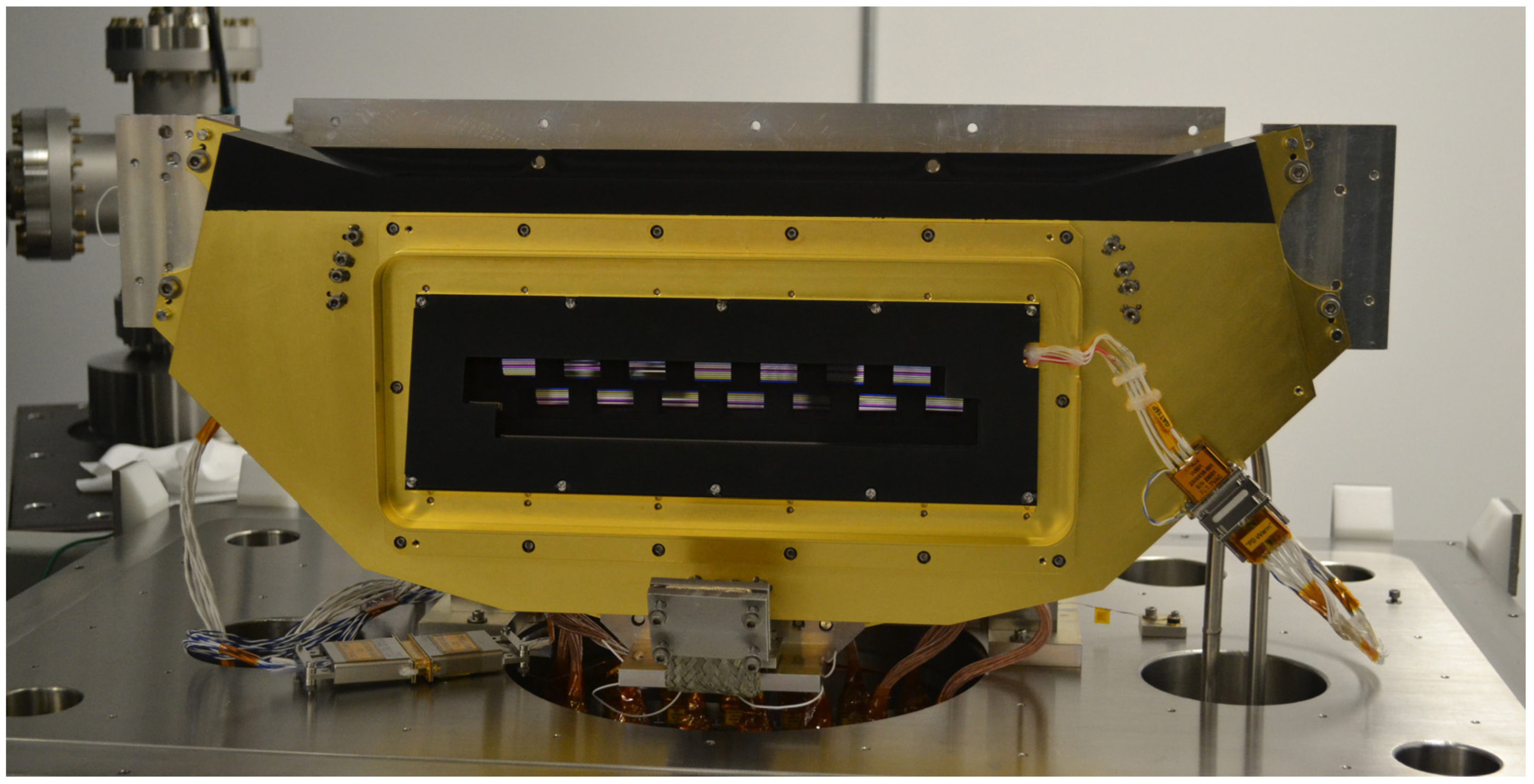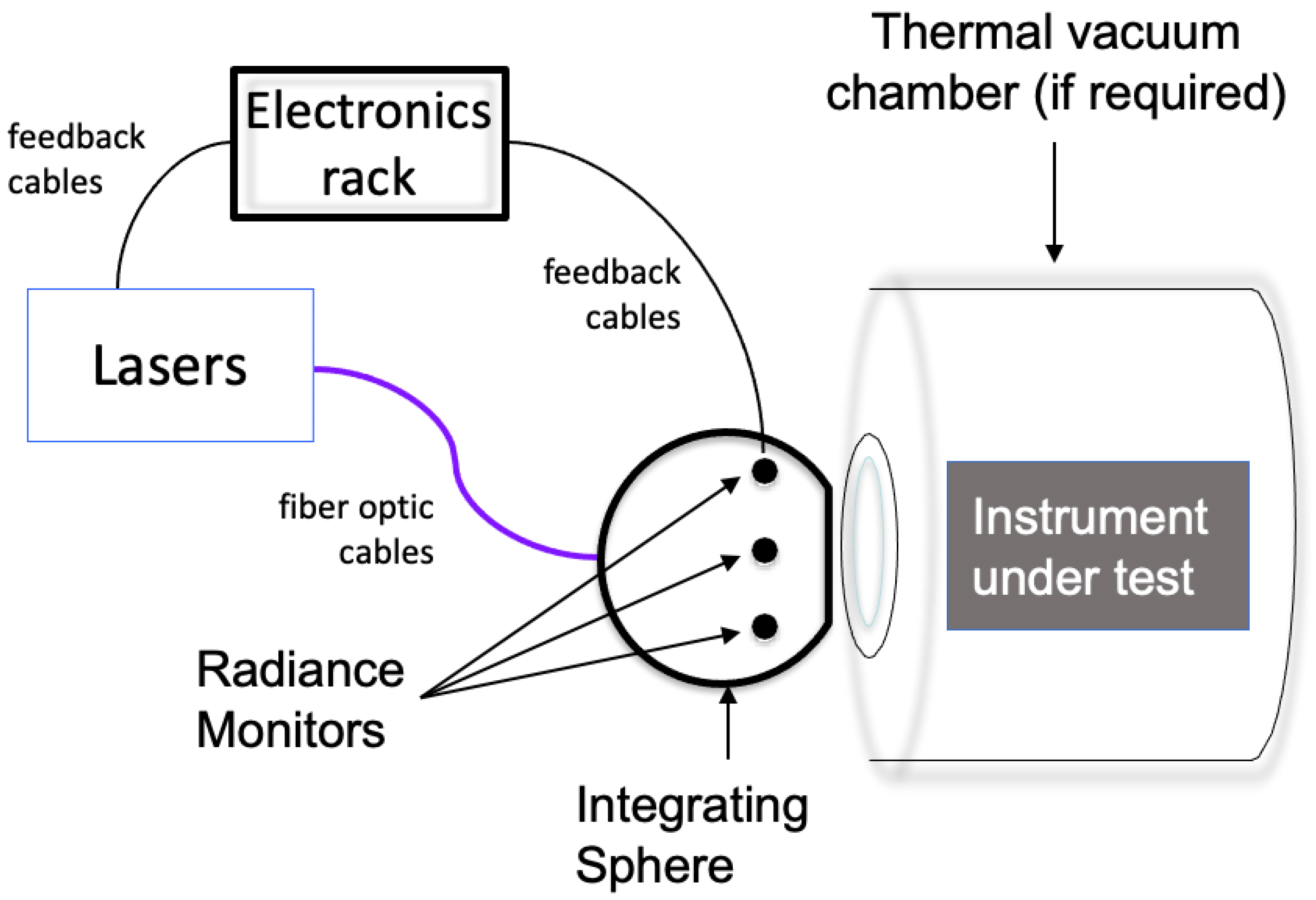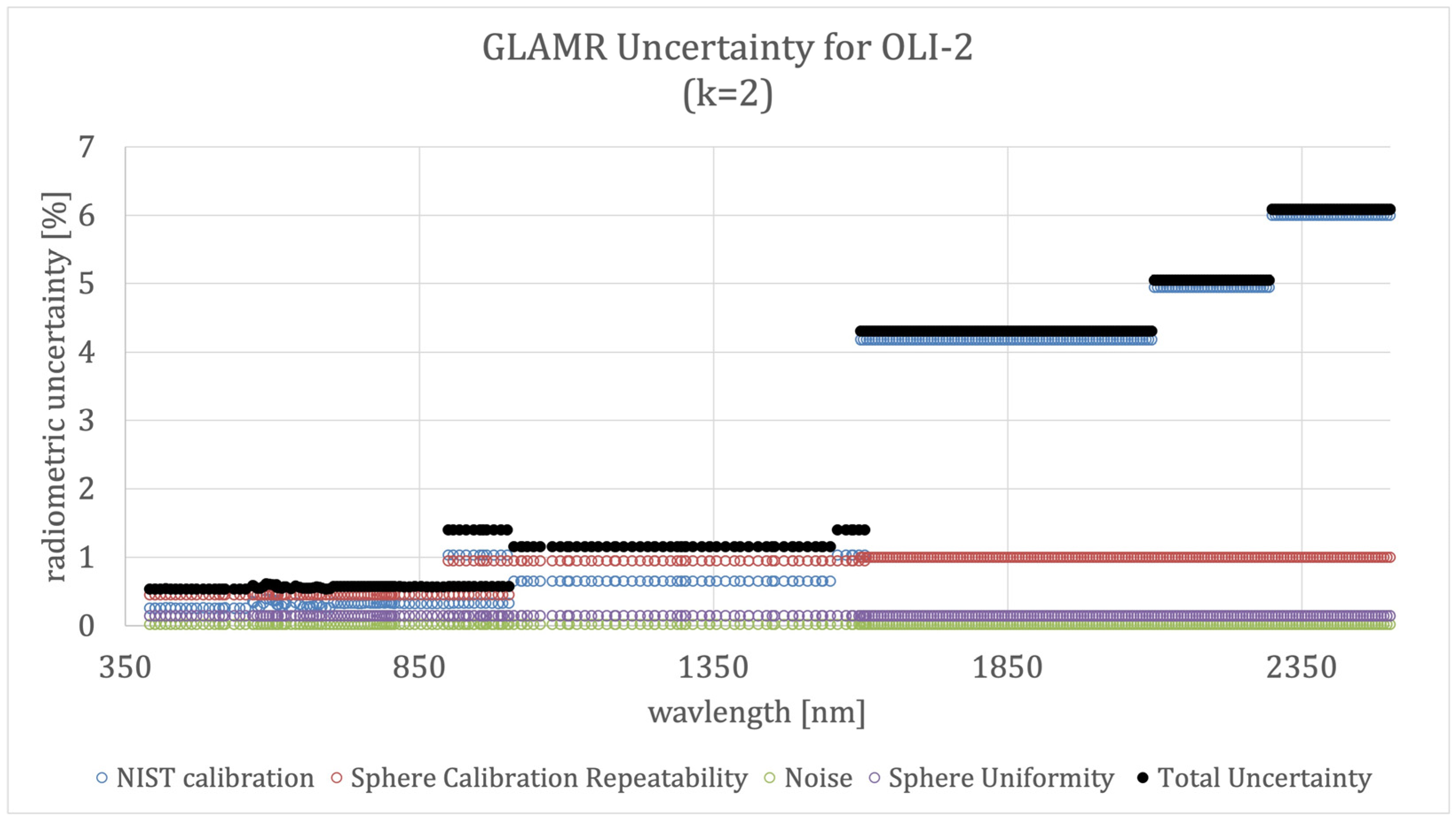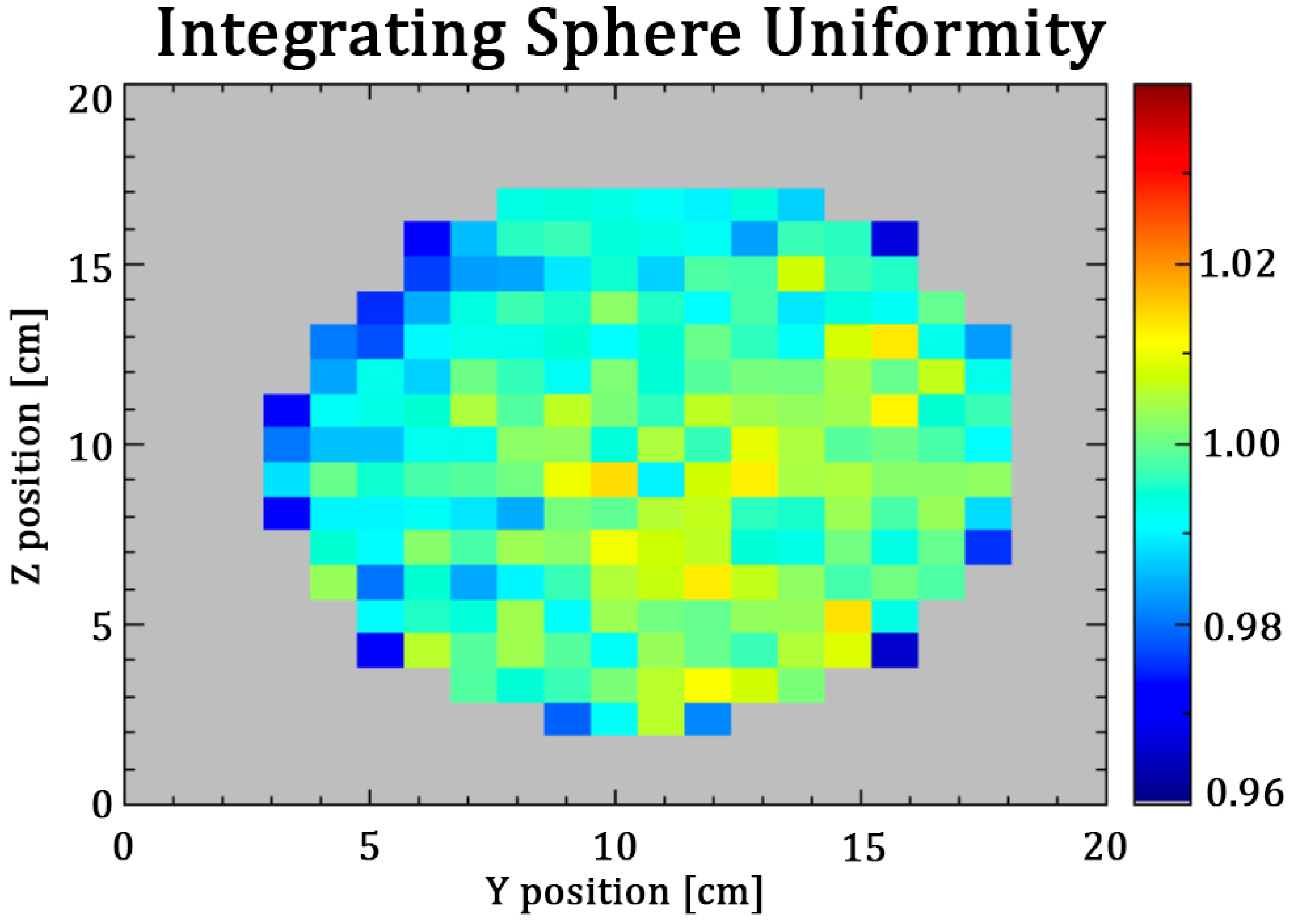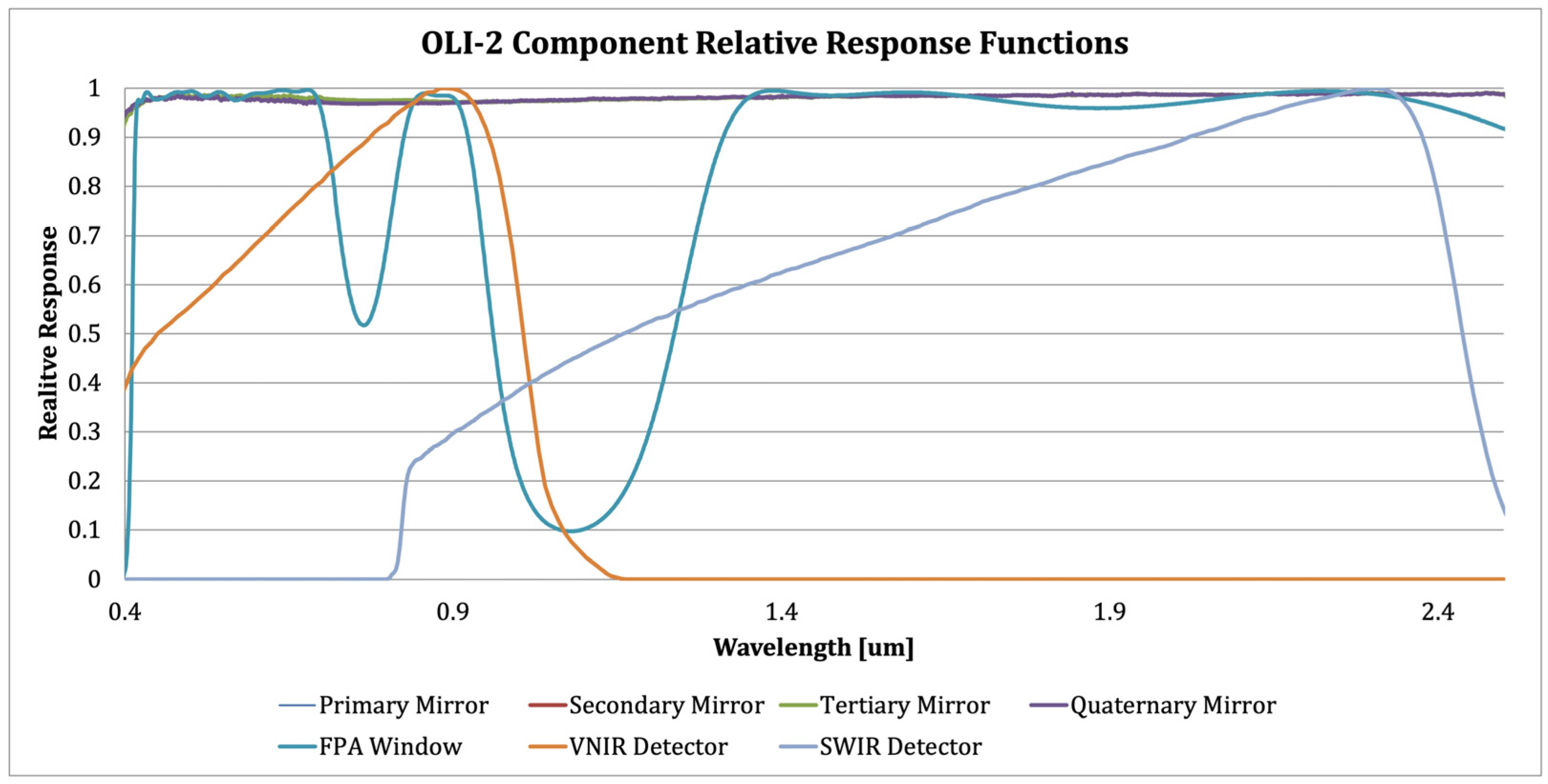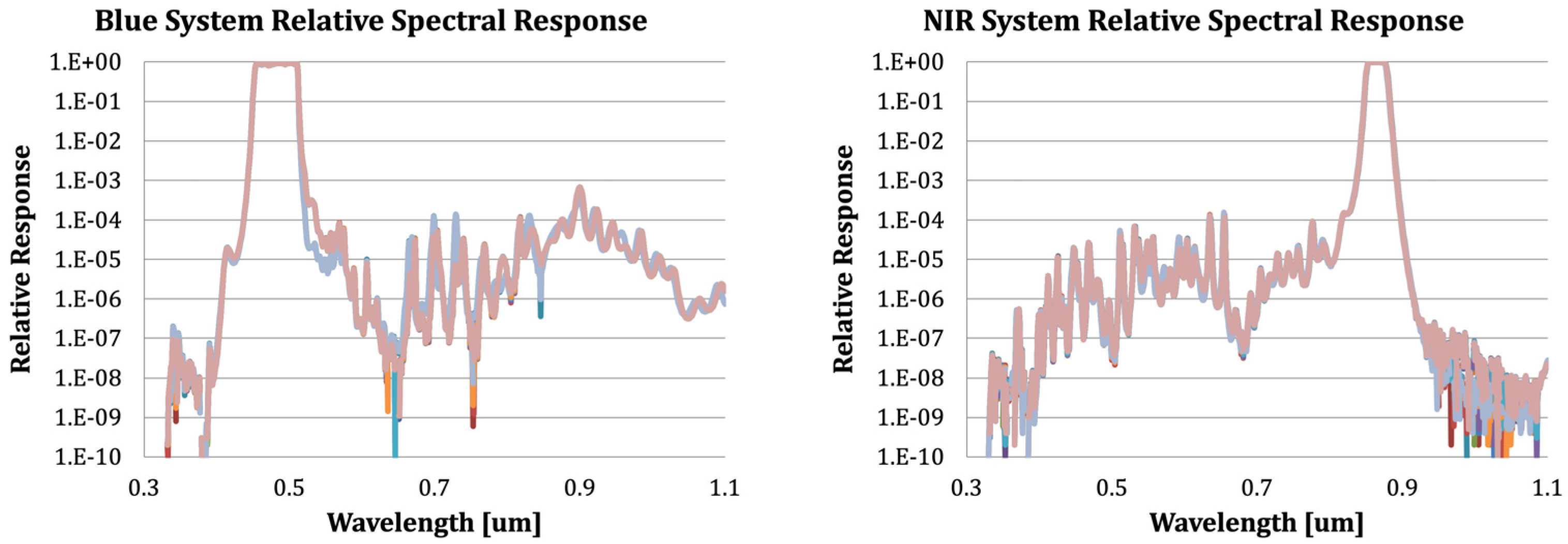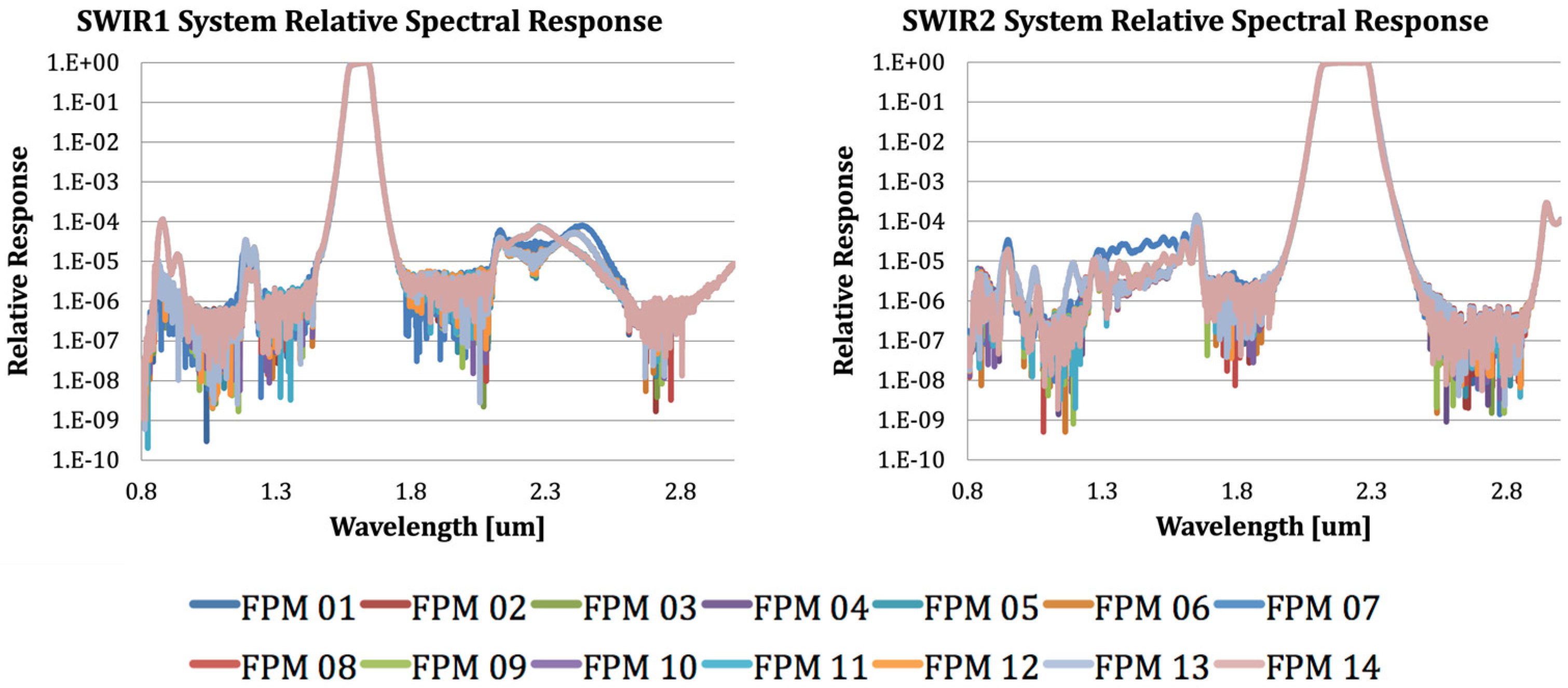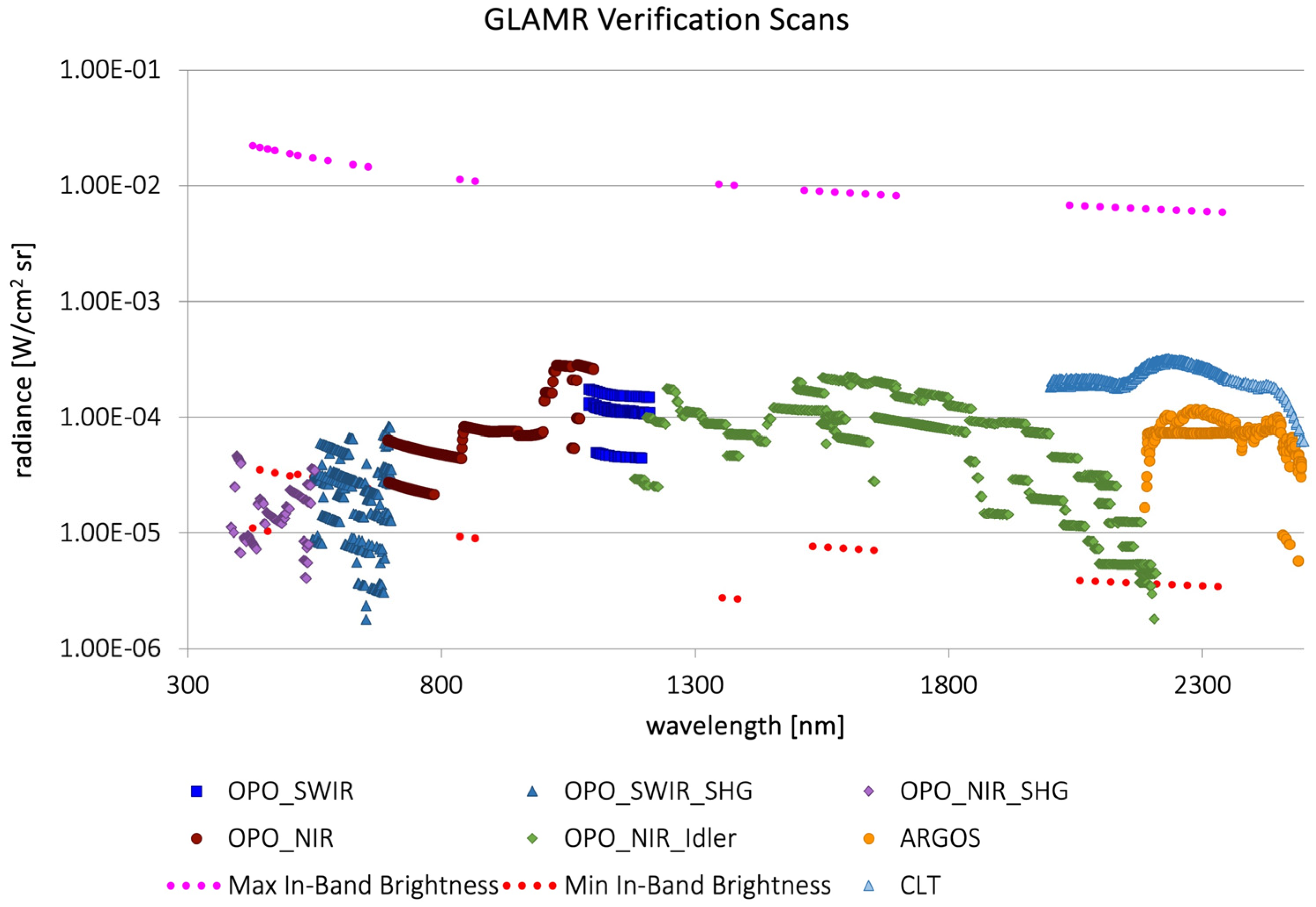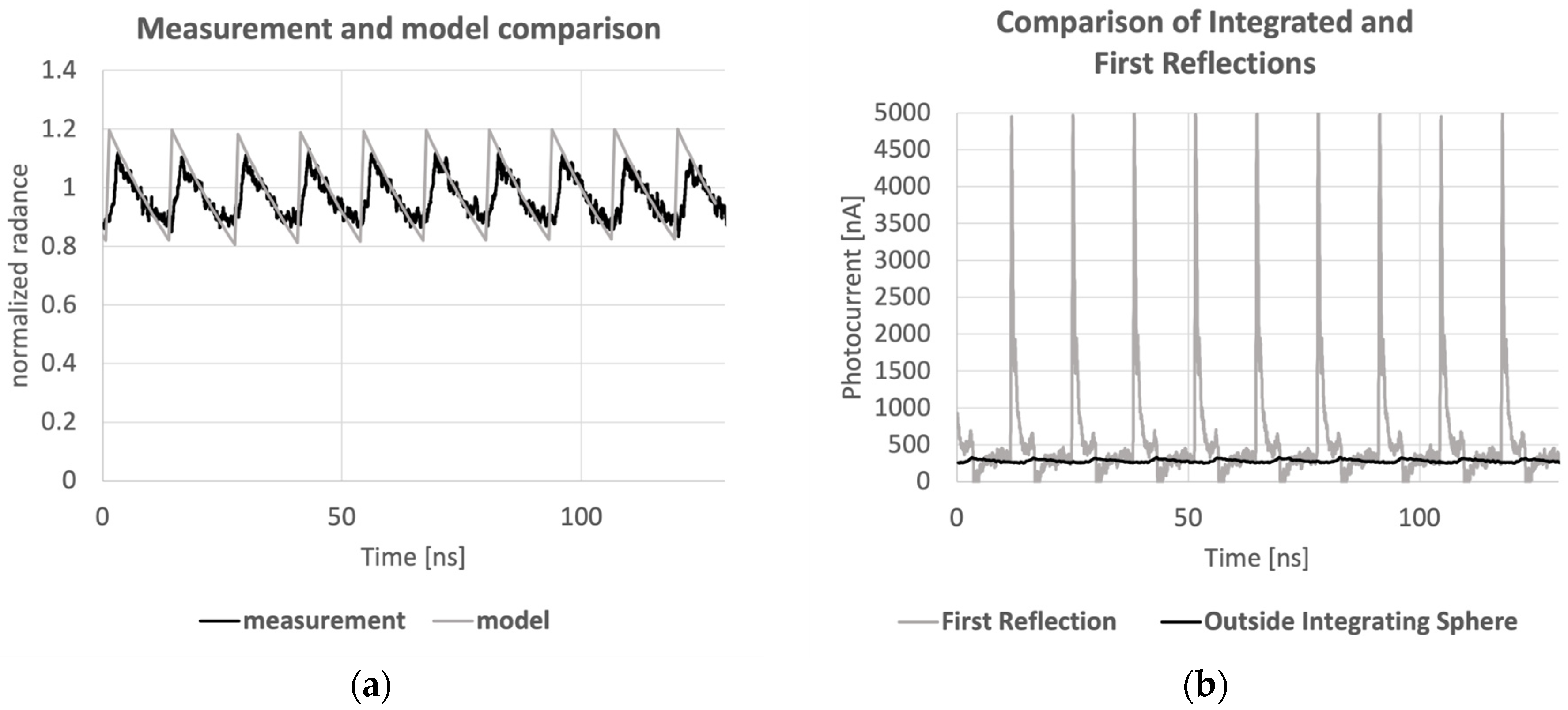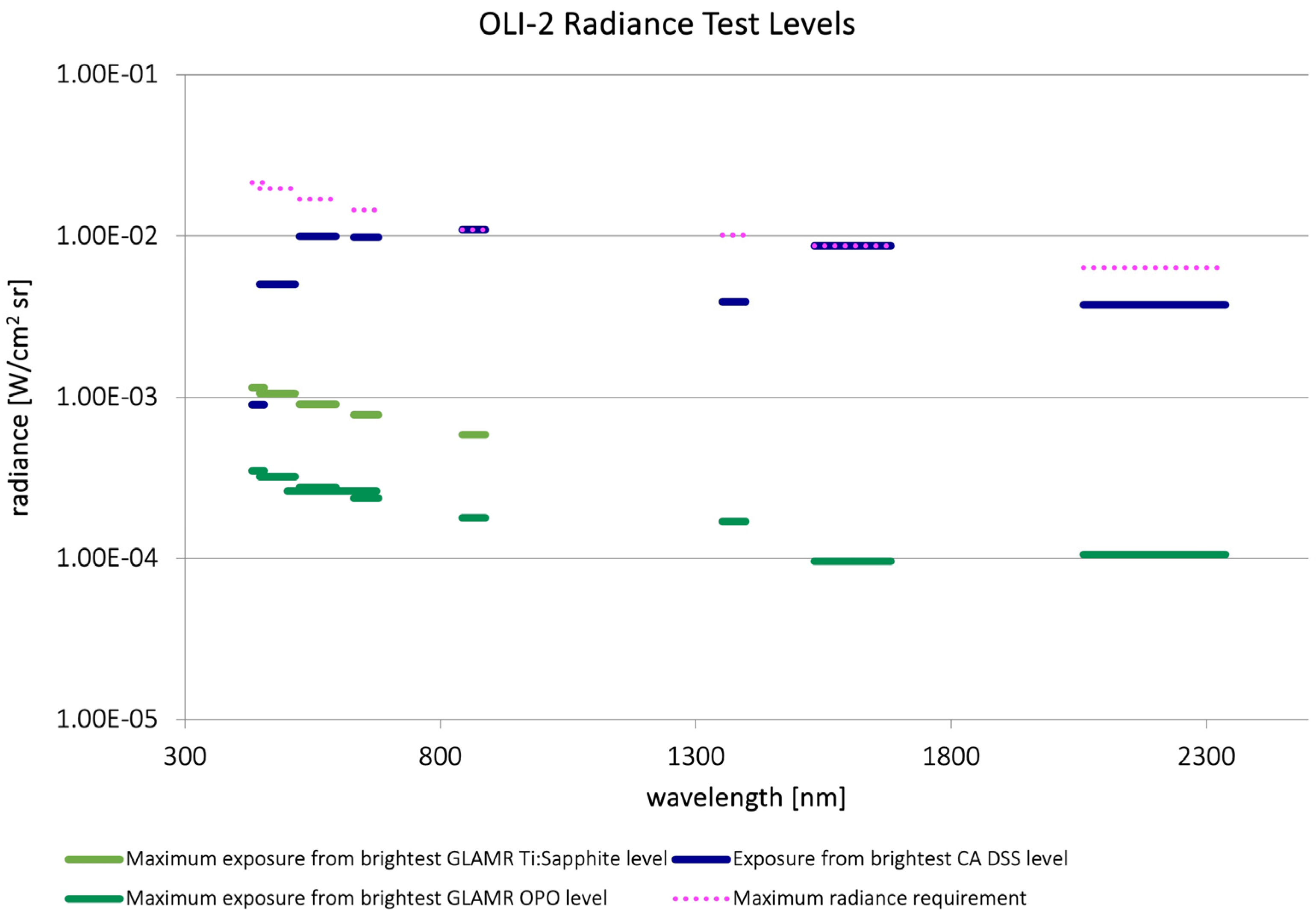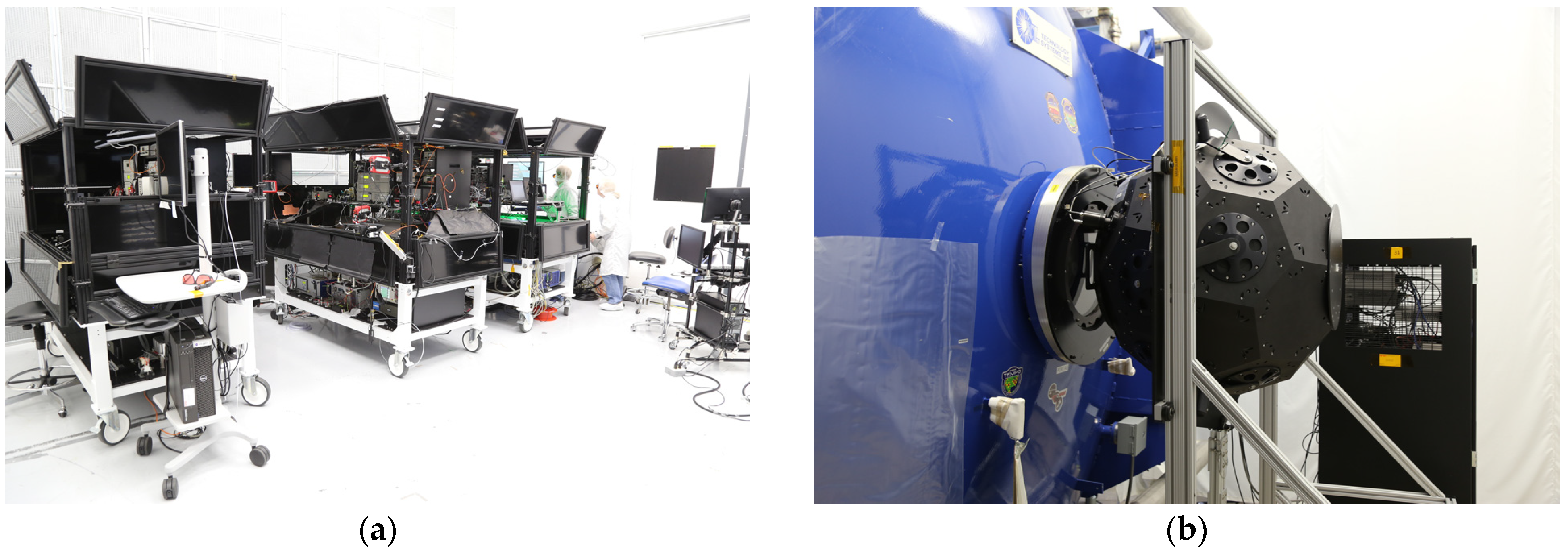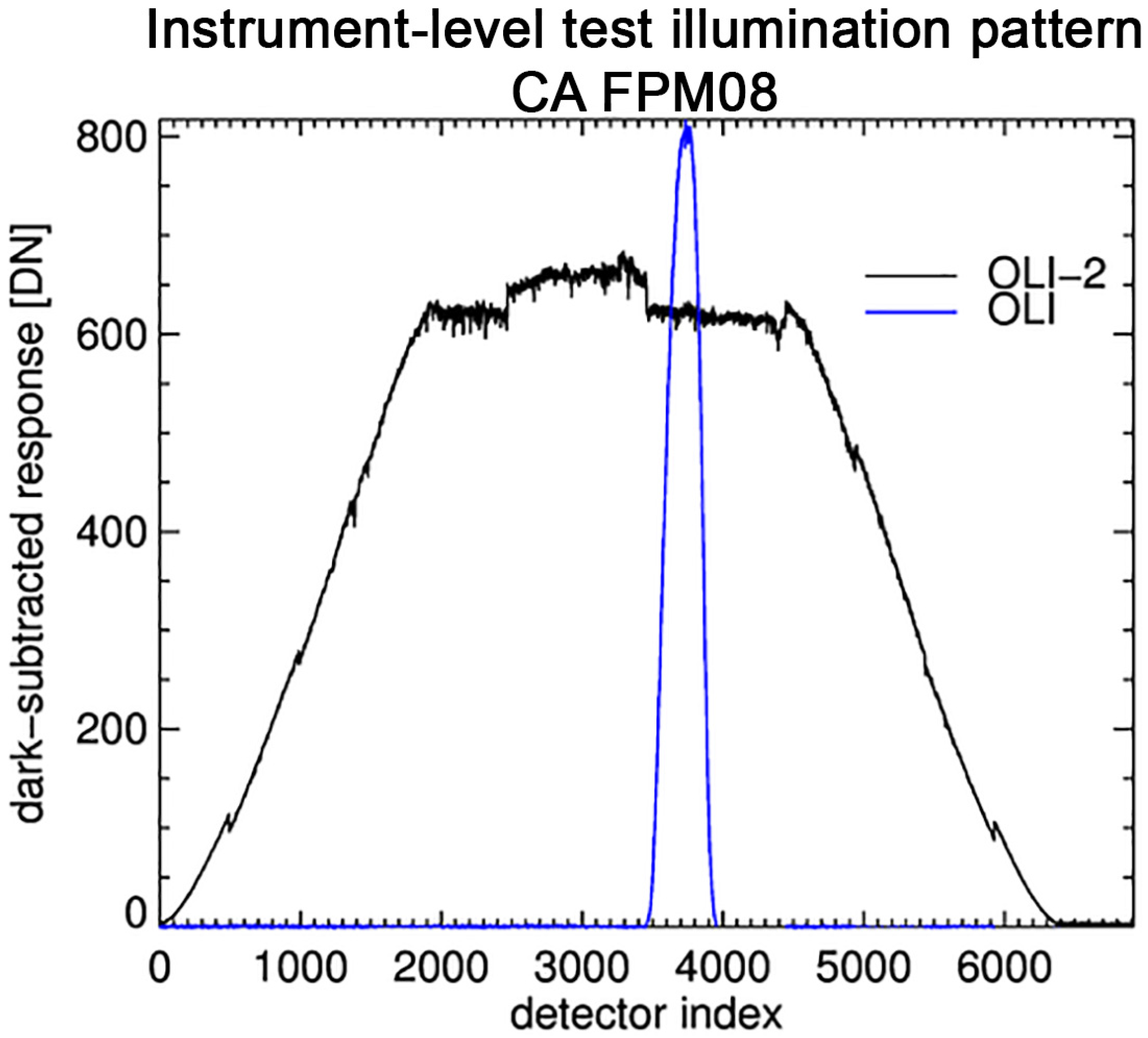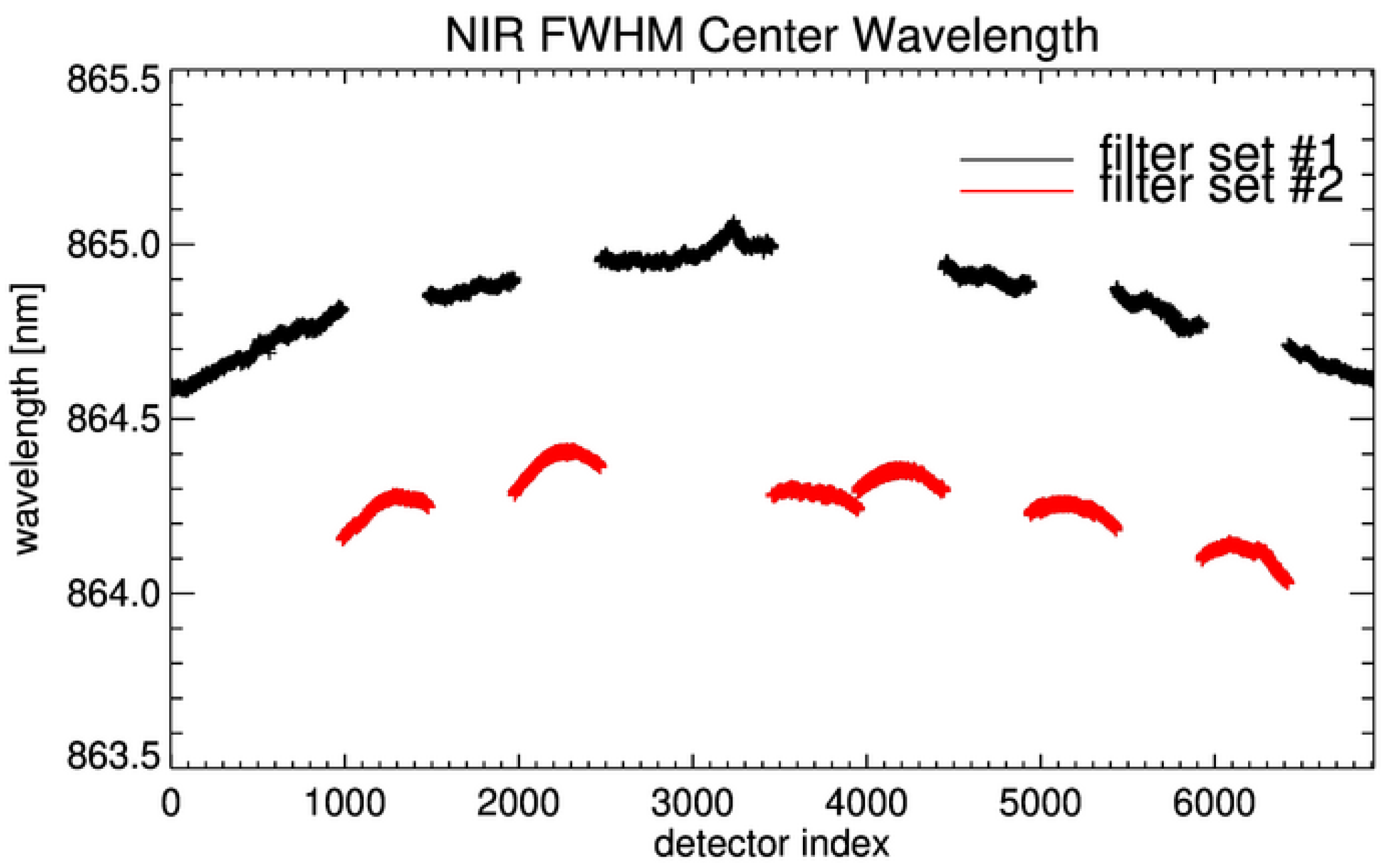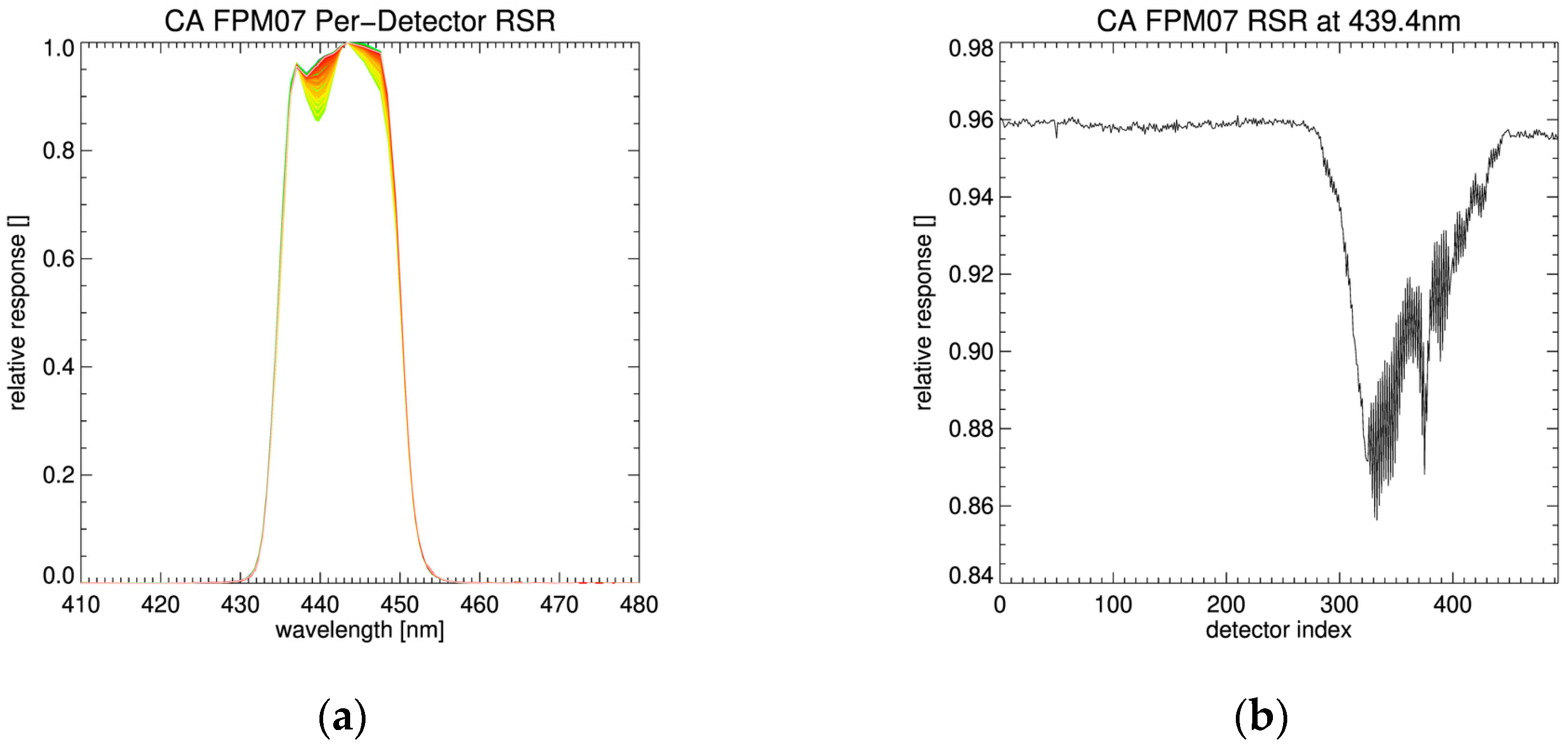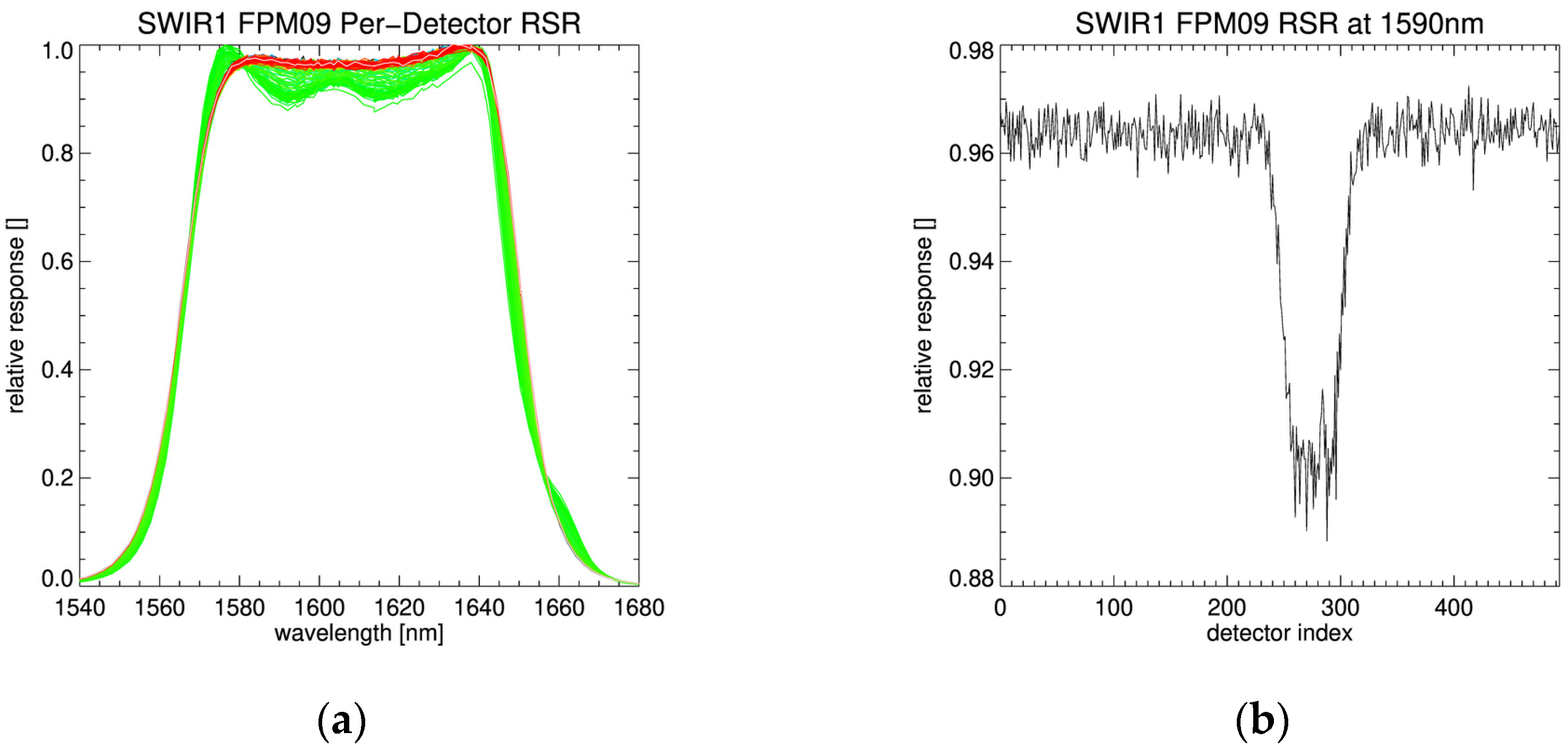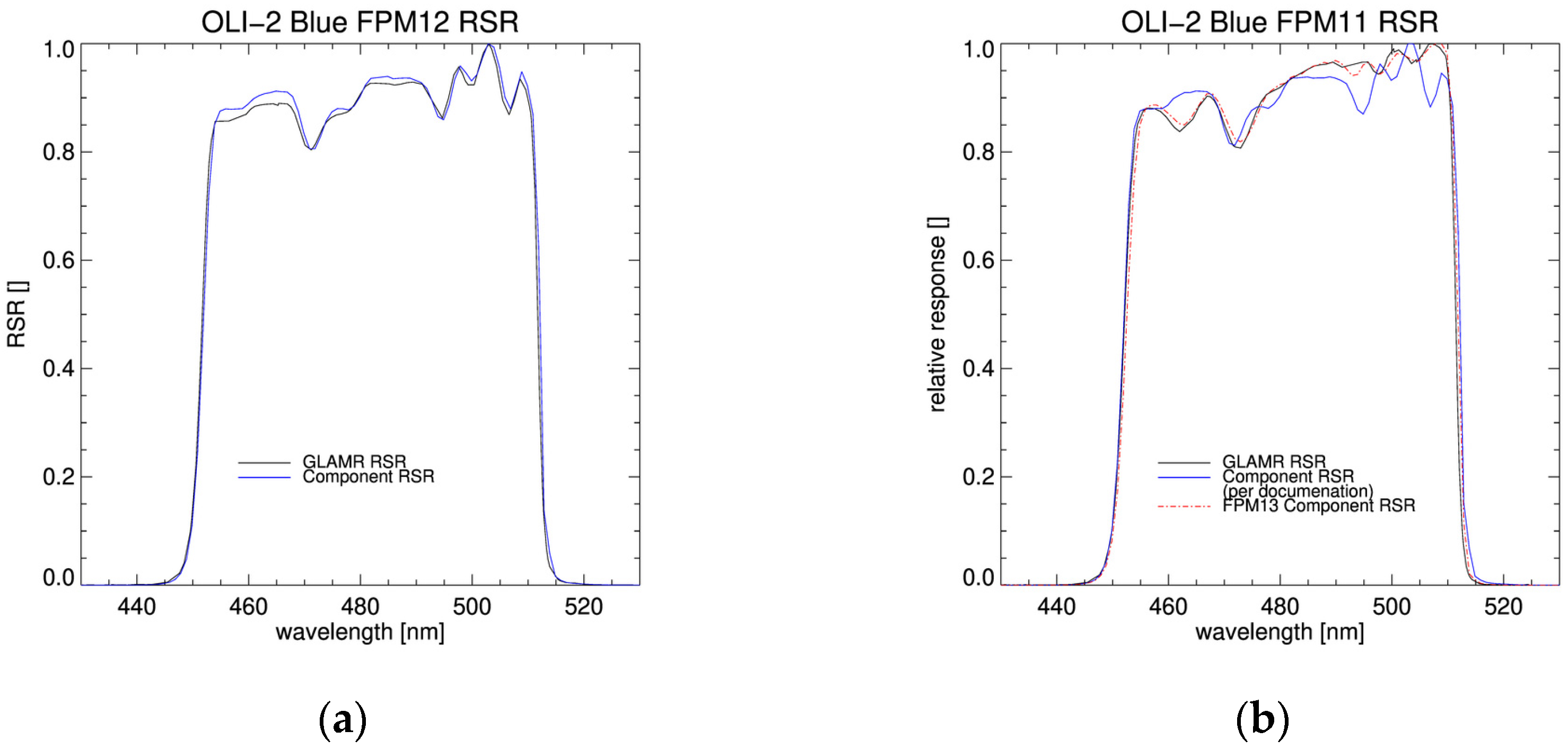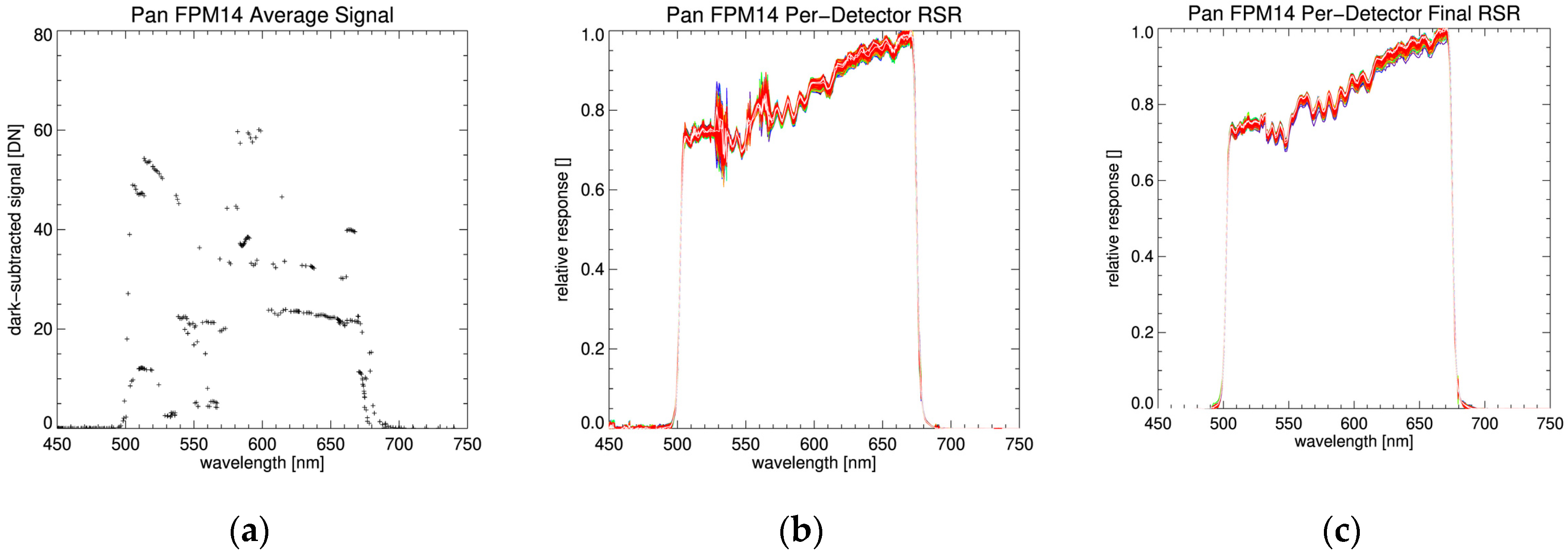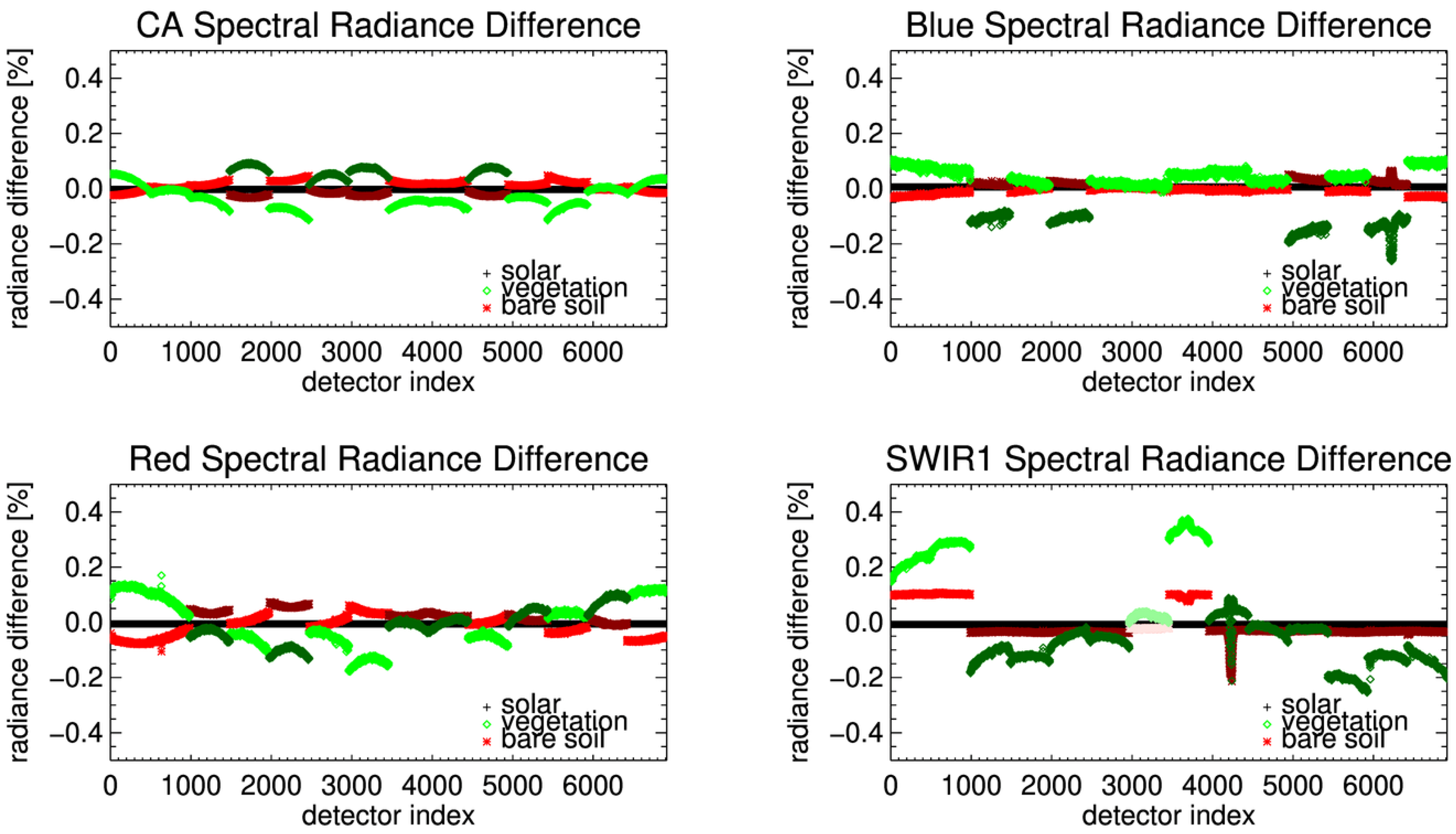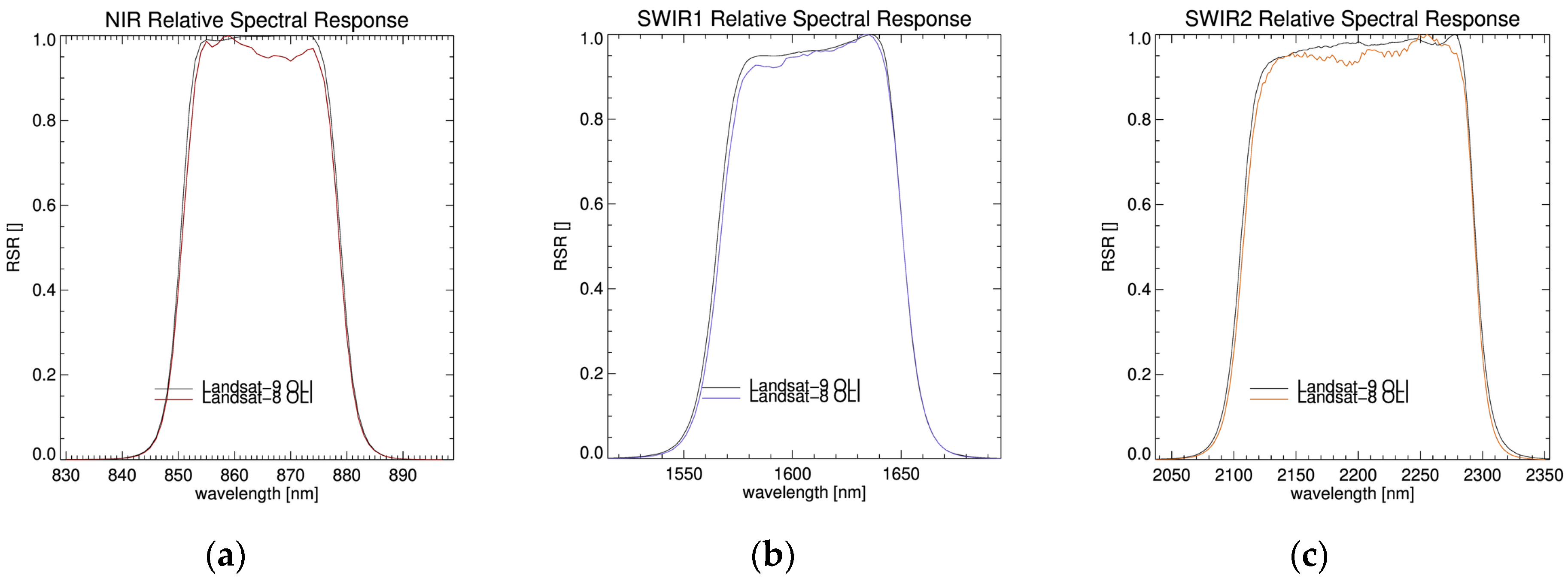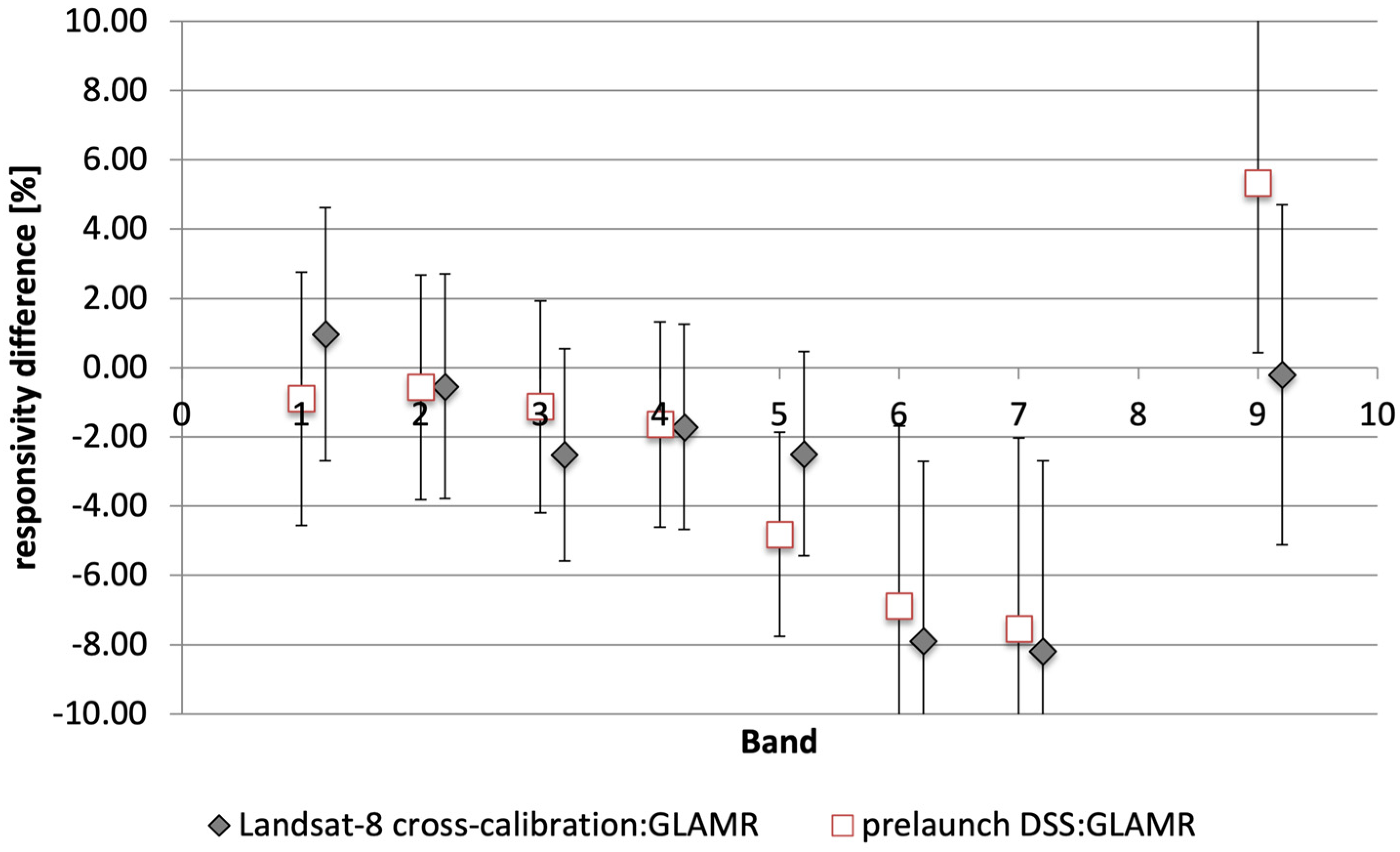Figure 1.
A photograph of the completed OLI-2 focal plane assembly. The butcher-block filter assemblies of each focal plane modules are visible through the focal plane assembly window. The band order of the filters from most off-axis to least off-axis is as follows: Cirrus, SWIR1, SWIR2, Green, Red, NIR, CA, Blue, Pan, such that on the assembled focal plane the Pan band arrays are closest together in the odd/even FPM pairs, and the Cirrus bands are furthest away. The modules are referred to by number, 1 through 14 (left to right). Source: Ball Aerospace.
Figure 1.
A photograph of the completed OLI-2 focal plane assembly. The butcher-block filter assemblies of each focal plane modules are visible through the focal plane assembly window. The band order of the filters from most off-axis to least off-axis is as follows: Cirrus, SWIR1, SWIR2, Green, Red, NIR, CA, Blue, Pan, such that on the assembled focal plane the Pan band arrays are closest together in the odd/even FPM pairs, and the Cirrus bands are furthest away. The modules are referred to by number, 1 through 14 (left to right). Source: Ball Aerospace.
Figure 2.
Notional diagram of the GLAMR setup, which would illuminate either transfer radiometer or the instrument under test.
Figure 2.
Notional diagram of the GLAMR setup, which would illuminate either transfer radiometer or the instrument under test.
Figure 3.
The per-wavelength GLAMR Uncertainty budget. The largest uncertainties are from the NIST calibration of the transfer radiometers, though the uncertainty in the repeatability of the GLAMR calibration process is significant above 900 nm.
Figure 3.
The per-wavelength GLAMR Uncertainty budget. The largest uncertainties are from the NIST calibration of the transfer radiometers, though the uncertainty in the repeatability of the GLAMR calibration process is significant above 900 nm.
Figure 4.
Spatial variability map of the NIST spherical integrating source as measured by scanning a 1° field-of-view radiometer across the port in a 20 × 20 grid in 1 cm intervals. The plot shows the relative brightness of each location relative to the mean 5 × 5 grid in the center.
Figure 4.
Spatial variability map of the NIST spherical integrating source as measured by scanning a 1° field-of-view radiometer across the port in a 20 × 20 grid in 1 cm intervals. The plot shows the relative brightness of each location relative to the mean 5 × 5 grid in the center.
Figure 5.
Relative transmission or reflectance of the OLI-2 optical path components over the entire spectral range of the instrument, including some out-of-band response. Detector responses are radiance (power) based.
Figure 5.
Relative transmission or reflectance of the OLI-2 optical path components over the entire spectral range of the instrument, including some out-of-band response. Detector responses are radiance (power) based.
Figure 6.
System-level relative radiance spectral response functions estimated from component-level measurements for each FPM of the OLI-2 Blue, NIR, SWIR1, and SWIR2 bands, including out-of-band response. The out-of-band response is below 0.001 in all FPMs of all bands.
Figure 6.
System-level relative radiance spectral response functions estimated from component-level measurements for each FPM of the OLI-2 Blue, NIR, SWIR1, and SWIR2 bands, including out-of-band response. The out-of-band response is below 0.001 in all FPMs of all bands.
Figure 7.
The OLI-2 VNIR bands and SWIR band out-of-band response based on FPM-level measurements with optical components (mirrors and FPA window) included analytically. The plots are scaled to show the out-of-band response, so the in-band response is not shown here.
Figure 7.
The OLI-2 VNIR bands and SWIR band out-of-band response based on FPM-level measurements with optical components (mirrors and FPA window) included analytically. The plots are scaled to show the out-of-band response, so the in-band response is not shown here.
Figure 8.
The radiances generated by the GLAMR system for requirements verification in February 2018 at typical power levels across the full spectral range required for the test. The requirement radiances, maximum in-band radiances, and minimum in-band radiances are also shown. The GLAMR power can be reduced such that the maximum in-band radiance will not be exceeded, but in general, these data were acquired at the maximum power that could be expected. This means that there will be wavelengths below 700 nm where the minimum in-band radiance will not be met. The minimum out-of-band radiances, which are higher than the minimum in-band radiances, are not shown here, but were generally not met below 700 nm.
Figure 8.
The radiances generated by the GLAMR system for requirements verification in February 2018 at typical power levels across the full spectral range required for the test. The requirement radiances, maximum in-band radiances, and minimum in-band radiances are also shown. The GLAMR power can be reduced such that the maximum in-band radiance will not be exceeded, but in general, these data were acquired at the maximum power that could be expected. This means that there will be wavelengths below 700 nm where the minimum in-band radiance will not be met. The minimum out-of-band radiances, which are higher than the minimum in-band radiances, are not shown here, but were generally not met below 700 nm.
Figure 9.
(a) The results of the integrating sphere model radiance output after the limit cycle is met (grey) with measurements of radiance exiting the sphere (black). (b) The signal from outside the integrating sphere (black) and inside the sphere on the wall near the first reflectance (grey). The black lines are the same data in both plots.
Figure 9.
(a) The results of the integrating sphere model radiance output after the limit cycle is met (grey) with measurements of radiance exiting the sphere (black). (b) The signal from outside the integrating sphere (black) and inside the sphere on the wall near the first reflectance (grey). The black lines are the same data in both plots.
Figure 10.
OLI-2 specification radiances (dotted lines) and exposure radiances for the GLAMR risk assessment (solid lines). The maximum radiance that OLI-2 spare module was exposed to during the GLAMR damage study was an order of magnitude lower than the radiance from the brightest DSS lamp level.
Figure 10.
OLI-2 specification radiances (dotted lines) and exposure radiances for the GLAMR risk assessment (solid lines). The maximum radiance that OLI-2 spare module was exposed to during the GLAMR damage study was an order of magnitude lower than the radiance from the brightest DSS lamp level.
Figure 11.
Per-detector responsivity of the NIR band as derived from exposure with the pulsed laser and the continuous wave laser, shown as relative to the mean from the continuous wave laser. The difference between them is about 1%, which is within the expected uncertainty of the measurements.
Figure 11.
Per-detector responsivity of the NIR band as derived from exposure with the pulsed laser and the continuous wave laser, shown as relative to the mean from the continuous wave laser. The difference between them is about 1%, which is within the expected uncertainty of the measurements.
Figure 12.
The GLAMR set up at Ball. The three OLAF tables are located in a room adjacent to the TVAC chamber (a). The integrating sphere and the TVAC chamber are shown in (b), before the final alignment of the sphere to the chamber window/OLI-2. Once complete, the space between the chamber window and the sphere was covered with a light-tight shroud. The energy from the laser tables is coupled to the integrating sphere via fiber optic cables and feedback from the sphere monitor radiometers for stability control is returned to the tables via BNC cables.
Figure 12.
The GLAMR set up at Ball. The three OLAF tables are located in a room adjacent to the TVAC chamber (a). The integrating sphere and the TVAC chamber are shown in (b), before the final alignment of the sphere to the chamber window/OLI-2. Once complete, the space between the chamber window and the sphere was covered with a light-tight shroud. The energy from the laser tables is coupled to the integrating sphere via fiber optic cables and feedback from the sphere monitor radiometers for stability control is returned to the tables via BNC cables.
Figure 13.
Sample illumination pattern of the GLAMR sphere across the OLI-2 focal plane (black). Each module is 494 detectors wide and can be distinguished by discontinuities in the response. The sphere fully illuminates 5 of the 14 modules at once. For the instrument level test, the OLI-2 was rotated so that the sphere was centered on each of the modules at every wavelength. For reference, the blue line illustrates the spatial coverage of the monochromator used for the characterization of OLI. The spectral response was measured for about 14% of the detectors during the OLI test, as opposed to 100% of the detectors for OLI-2. Note that this plot is only intended to illustrate the difference in the illumination pattern, not the absolute signal levels.
Figure 13.
Sample illumination pattern of the GLAMR sphere across the OLI-2 focal plane (black). Each module is 494 detectors wide and can be distinguished by discontinuities in the response. The sphere fully illuminates 5 of the 14 modules at once. For the instrument level test, the OLI-2 was rotated so that the sphere was centered on each of the modules at every wavelength. For reference, the blue line illustrates the spatial coverage of the monochromator used for the characterization of OLI. The spectral response was measured for about 14% of the detectors during the OLI test, as opposed to 100% of the detectors for OLI-2. Note that this plot is only intended to illustrate the difference in the illumination pattern, not the absolute signal levels.
Figure 14.
Progression of the GLAMR illumination across the OLI-2 focal plane. Each circle represents the projection of the GLAMR sphere port on the focal plane, covering about five modules at once; one circle is yellow to clarify a single image’s coverage. Each wavelength measurement would begin with the GLAMR beam centered on either FPM1 or FPM14. The OLI-2 would capture a two-second image then rotate by about 1° to center on the next module. The process to capture images centered on every module for each wavelength took two minutes.
Figure 14.
Progression of the GLAMR illumination across the OLI-2 focal plane. Each circle represents the projection of the GLAMR sphere port on the focal plane, covering about five modules at once; one circle is yellow to clarify a single image’s coverage. Each wavelength measurement would begin with the GLAMR beam centered on either FPM1 or FPM14. The OLI-2 would capture a two-second image then rotate by about 1° to center on the next module. The process to capture images centered on every module for each wavelength took two minutes.
Figure 15.
The GLAMR signal (a) and radiometric (b) and spectral (c) stability over the two minutes that OLI-2 was capturing images. In (a), the radiance level achieved for every valid measurement shown and is compared to the maximum and minimum requirement radiances. The radiances below 700 nm are close to the minimum or below. Note that these data have been screened for 1% radiometric stability over 2 min, but only data with 0.01% radiometric stability or better over the 2 s of each OLI-2 image acquisition were used for generation of the RSR.
Figure 15.
The GLAMR signal (a) and radiometric (b) and spectral (c) stability over the two minutes that OLI-2 was capturing images. In (a), the radiance level achieved for every valid measurement shown and is compared to the maximum and minimum requirement radiances. The radiances below 700 nm are close to the minimum or below. Note that these data have been screened for 1% radiometric stability over 2 min, but only data with 0.01% radiometric stability or better over the 2 s of each OLI-2 image acquisition were used for generation of the RSR.
Figure 16.
The module-average in-band relative spectral response of all nine OLI-2 spectral bands as measured by GLAMR. Each module is represented by a different color.
Figure 16.
The module-average in-band relative spectral response of all nine OLI-2 spectral bands as measured by GLAMR. Each module is represented by a different color.
Figure 17.
The per-detector center wavelength across the focal plane for the NIR band. Differences are the result of filter wafer source and the change in angle-of-incidence. The red and black series distinguish between modules built with common filter sources and the offset between the two is expected. The overall frown shape across the focal plane is the result of the angle-of-incidence and is also expected.
Figure 17.
The per-detector center wavelength across the focal plane for the NIR band. Differences are the result of filter wafer source and the change in angle-of-incidence. The red and black series distinguish between modules built with common filter sources and the offset between the two is expected. The overall frown shape across the focal plane is the result of the angle-of-incidence and is also expected.
Figure 18.
The per-detector RSR for the CA band FPM07 (a), where each detector’s response is a different color, and the response at 439.4 nm across every detector (b). The variation in the response between 435 and 445 nm is apparent in (a). About 170 detectors are affected by what is likely an imperfection in the filter, where the response drops from about 0.955 to as low as 0.86 (b).
Figure 18.
The per-detector RSR for the CA band FPM07 (a), where each detector’s response is a different color, and the response at 439.4 nm across every detector (b). The variation in the response between 435 and 445 nm is apparent in (a). About 170 detectors are affected by what is likely an imperfection in the filter, where the response drops from about 0.955 to as low as 0.86 (b).
Figure 19.
The per-detector RSR for the SWIR1 band FPM09 (a), where each detector’s response is a different color, and the response at 1590 nm across every detector (b). The variation in the response across the high response region is apparent in (a). About 100 detectors are affected by what is likely an imperfection in the filter, where the response drops from about 0.965 to as low as 0.89 (b).
Figure 19.
The per-detector RSR for the SWIR1 band FPM09 (a), where each detector’s response is a different color, and the response at 1590 nm across every detector (b). The variation in the response across the high response region is apparent in (a). About 100 detectors are affected by what is likely an imperfection in the filter, where the response drops from about 0.965 to as low as 0.89 (b).
Figure 20.
The per-detector RSR for the Blue band FPM13 (a), where each detector’s response is a different color, and the bandwidth at the 50% response points for every detector in FPM13 (b). The variation in the response across the high response region and the lower band edge are apparent in (a). About 70 detectors are affected by what is likely an imperfection in the filter, where the bandwidth narrows by up to 1 nm (b).
Figure 20.
The per-detector RSR for the Blue band FPM13 (a), where each detector’s response is a different color, and the bandwidth at the 50% response points for every detector in FPM13 (b). The variation in the response across the high response region and the lower band edge are apparent in (a). About 70 detectors are affected by what is likely an imperfection in the filter, where the bandwidth narrows by up to 1 nm (b).
Figure 21.
The module-average relative spectral response for two OLI-2 modules in the Blue band at the instrument-level and as predicted from the component-level measurements. The GLAMR results match the component-level prediction very well for FPM12 (
a), but there are significant differences in the features in FPM11 (
b). There were two different wafers used as the source of the Blue band filter sticks; it is likely that the filter stick used on FPM11 originated from the other wafer. The FPM13 component-level RSR is shown on (
b) to illustrate the better match with the other wafer.
Table 2 reflects this discovery.
Figure 21.
The module-average relative spectral response for two OLI-2 modules in the Blue band at the instrument-level and as predicted from the component-level measurements. The GLAMR results match the component-level prediction very well for FPM12 (
a), but there are significant differences in the features in FPM11 (
b). There were two different wafers used as the source of the Blue band filter sticks; it is likely that the filter stick used on FPM11 originated from the other wafer. The FPM13 component-level RSR is shown on (
b) to illustrate the better match with the other wafer.
Table 2 reflects this discovery.
Figure 22.
The OLI-2 average signal level for one module of the Pan band (a). Low signal levels in the degeneracy region of the OPO (~532 nm) and where the efficiency of two OPO configurations are falling off (between 550 and 570 nm) result in noisy RSR at those wavelengths, as illustrated in (b) of the RSR for all 988 detectors on the module, where each detector’s response is represented by a different color. In (c), the per-detector RSR with the low-signal regions are smoothed to better represent instrument response rather than noise.
Figure 22.
The OLI-2 average signal level for one module of the Pan band (a). Low signal levels in the degeneracy region of the OPO (~532 nm) and where the efficiency of two OPO configurations are falling off (between 550 and 570 nm) result in noisy RSR at those wavelengths, as illustrated in (b) of the RSR for all 988 detectors on the module, where each detector’s response is represented by a different color. In (c), the per-detector RSR with the low-signal regions are smoothed to better represent instrument response rather than noise.
Figure 23.
The module-average relative spectral response for all 14 OLI-2 module in each band. Each module is a different color. Due to the lack of power in below ~700 nm, the GLAMR measurements were not used for final assessment of out-of-band response in the VNIR bands. All three SWIR bands exhibit some amount of cross-talk, which was expected based on OLI results.
Figure 23.
The module-average relative spectral response for all 14 OLI-2 module in each band. Each module is a different color. Due to the lack of power in below ~700 nm, the GLAMR measurements were not used for final assessment of out-of-band response in the VNIR bands. All three SWIR bands exhibit some amount of cross-talk, which was expected based on OLI results.
Figure 24.
The effect of speckle on the OLI-2 imagery. In (a), the image was acquired with no speckle; the fiber was being vibrated for the duration of the image. In (b), the image was acquired while the fiber was being vibrated, but the vibrations stopped for two very short periods, apparent at about line 275 and 325. In (c), the image was acquired without the fiber being vibrated, and the impact is apparent in the non-uniformity across the detectors. Speckle increases the noise across the detectors from about 1.5% to about 9%. The images are all scaled to about 1000 counts to aid in the visibility of the different noise levels.
Figure 24.
The effect of speckle on the OLI-2 imagery. In (a), the image was acquired with no speckle; the fiber was being vibrated for the duration of the image. In (b), the image was acquired while the fiber was being vibrated, but the vibrations stopped for two very short periods, apparent at about line 275 and 325. In (c), the image was acquired without the fiber being vibrated, and the impact is apparent in the non-uniformity across the detectors. Speckle increases the noise across the detectors from about 1.5% to about 9%. The images are all scaled to about 1000 counts to aid in the visibility of the different noise levels.
Figure 25.
Plots of signal over time for the first detector in each image shown in
Figure 24. When there is no speckle, the typical signal varies by less than 1.5%. With speckle, the typical signal varies by 6%.
Figure 25.
Plots of signal over time for the first detector in each image shown in
Figure 24. When there is no speckle, the typical signal varies by less than 1.5%. With speckle, the typical signal varies by 6%.
Figure 26.
Top-of-atmosphere radiances for two surface types to be used in OLI-2 simulations. These are the same targets used for OLI simulation.
Figure 26.
Top-of-atmosphere radiances for two surface types to be used in OLI-2 simulations. These are the same targets used for OLI simulation.
Figure 27.
The spectral radiance difference across the focal plane for the standard target types as a result of per-detector differences in the RSR and the lack of telecentricity in the telescope. The shades of red and green represent the different source filter across the focal plane (see
Table 2). The largest discontinuities are the result of spectral mismatches at the edges of modules. Internal to each module, the differences are generally very small except for modules where features were discovered in the filter material (i.e., SWIR1 FPM09).
Figure 27.
The spectral radiance difference across the focal plane for the standard target types as a result of per-detector differences in the RSR and the lack of telecentricity in the telescope. The shades of red and green represent the different source filter across the focal plane (see
Table 2). The largest discontinuities are the result of spectral mismatches at the edges of modules. Internal to each module, the differences are generally very small except for modules where features were discovered in the filter material (i.e., SWIR1 FPM09).
Figure 28.
A comparison of the OLI-2 and OLI band-average RSR for sample bands.
Figure 28.
A comparison of the OLI-2 and OLI band-average RSR for sample bands.
Figure 29.
The comparison of the integrated spectral radiance for OLI-2 and OLI band-average RSR. For these target types, the radiances agree within 0.5% based strictly on the relative spectral response, except for the Pan band vegetation radiance, which is off the scale of this plot at 1.45% different.
Figure 29.
The comparison of the integrated spectral radiance for OLI-2 and OLI band-average RSR. For these target types, the radiances agree within 0.5% based strictly on the relative spectral response, except for the Pan band vegetation radiance, which is off the scale of this plot at 1.45% different.
Figure 30.
Comparison of DSS-derived OLI-2 responsivities and GLAMR derived responsivities. The error bars are the RSS of the DSS radiometric uncertainty and the GLAMR radiometric uncertainty.
Figure 30.
Comparison of DSS-derived OLI-2 responsivities and GLAMR derived responsivities. The error bars are the RSS of the DSS radiometric uncertainty and the GLAMR radiometric uncertainty.
Table 1.
Landsat-9 OLI-2 spectral bands, as defined by the requirements. The upper and lower band edges are defined at the 50% response point and the center wavelength is the mid-point between edges.
Table 1.
Landsat-9 OLI-2 spectral bands, as defined by the requirements. The upper and lower band edges are defined at the 50% response point and the center wavelength is the mid-point between edges.
| Spectral Band | Spatial
Resolution [m] | Minimum Lower Band Edge [nm] | Maximum Upper Band Edge [nm] | Center
Wavelength [nm] |
|---|
| Coastal/Aerosol (CA) | 30 | 433 | 453 | 443 ± 2 |
| Blue | 30 | 450 | 515 | 482 ± 5 |
| Green | 30 | 525 | 600 | 562 ± 5 |
| Red | 30 | 630 | 680 | 655 ± 5 |
| NIR | 30 | 845 | 885 | 865 ± 5 |
| SWIR1 | 30 | 1560 | 1660 | 1610 ± 10 |
| SWIR2 | 30 | 2100 | 2300 | 2200 ± 10 |
| Pan | 15 | 500 | 680 | 590 ± 10 |
| Cirrus | 30 | 1360 | 1390 | 1375 ± 5 |
Table 2.
Filter wafer distribution across the OLI-2 focal plane. Numbers indicate which wafer was the source of the filter for each module (colors are to aid in visibility). Italicized numbers indicate that filter sticks from that wafer were also used on the OLI focal plane. Unlike for OLI, no band consists of filters from only one wafter source. SWIR1 and SWIR2 have filters from three different source wafers. The wafer numbers are indexed continuously from the OLI build, so can be compared to the OLI table in [
1].
Table 2.
Filter wafer distribution across the OLI-2 focal plane. Numbers indicate which wafer was the source of the filter for each module (colors are to aid in visibility). Italicized numbers indicate that filter sticks from that wafer were also used on the OLI focal plane. Unlike for OLI, no band consists of filters from only one wafter source. SWIR1 and SWIR2 have filters from three different source wafers. The wafer numbers are indexed continuously from the OLI build, so can be compared to the OLI table in [
1].
| FPM Number | CA | Blue | Green | Red | NIR | Cirrus | SWIR1 | SWIR2 | Pan |
|---|
| 1 | 3 | 2 | 3 | 3 | 3 | 4 | 4 | 3 | 4 |
| 2 | 3 | 2 | 3 | 3 | 3 | 4 | 4 | 3 | 4 |
| 3 | 3 | 1 | 2 | 2 | 1 | 4 | 3 | 3 | 3 |
| 4 | 4 | 2 | 3 | 3 | 3 | 5 | 3 | 4 | 4 |
| 5 | 3 | 1 | 2 | 2 | 1 | 4 | 3 | 3 | 3 |
| 6 | 4 | 2 | 3 | 3 | 3 | 5 | 3 | 4 | 4 |
| 7 | 4 | 2 | 3 | 3 | 3 | 5 | 2 | 5 | 4 |
| 8 | 3 | 2 | 2 | 2 | 1 | 4 | 4 | 3 | 3 |
| 9 | 3 | 2 | 2 | 2 | 1 | 5 | 3 | 4 | 3 |
| 10 | 4 | 2 | 3 | 3 | 3 | 4 | 3 | 3 | 4 |
| 11 | 3 | 1 | 2 | 2 | 1 | 5 | 3 | 4 | 3 |
| 12 | 3 | 2 | 3 | 3 | 3 | 4 | 3 | 3 | 4 |
| 13 | 3 | 1 | 2 | 2 | 1 | 4 | 3 | 3 | 3 |
| 14 | 3 | 2 | 3 | 3 | 3 | 5 | 3 | 4 | 4 |
Table 3.
GLAMR laser configuration and spectral coverage used for OLI-2 characterization.
Table 3.
GLAMR laser configuration and spectral coverage used for OLI-2 characterization.
| Laser Configuration | Spectral Range | Pulse Repetition Frequency |
|---|
| OPO_NIR_SHG | 350–550 nm | 76 or 80 MHz Pulsed |
| OPO_SWIR_SHG | 550–700 nm | 76 or 80 MHz Pulsed |
| OPO_NIR | 700–1100 nm | 76 or 80 MHz Pulsed |
| OPO_SWIR | 1100–1350 nm | 76 or 80 MHz Pulsed |
| OPO_NIR_Idler | 1350–2200 nm | 76 or 80 MHz Pulsed |
| CLT | 1900–2500 nm | Continuous wave |
| ARGOS | 2200–2500 nm | Continuous wave |
Table 4.
Total GLAMR uncertainty for each of the OLI-2 spectral bands.
Table 4.
Total GLAMR uncertainty for each of the OLI-2 spectral bands.
| Spectral Band | Center Wavelength [nm] | GLAMR Total
Uncertainty (k = 2) [%] |
|---|
| CA | 443 ± 2 | 0.5 |
| Blue | 482 ± 5 | 0.5 |
| Green | 562 ± 5 | 0.5 |
| Red | 655 ± 5 | 0.5 |
| NIR | 865 ± 5 | 0.6 |
| SWIR1 | 1610 ± 10 | 4.3 |
| SWIR2 | 2200 ± 10 | 4.3 |
| Pan | 590 ± 10 | 0.6 |
| Cirrus | 1375 ± 5 | 1.2 |
Table 5.
A sample of the Ball Aerospace requirements on the GLAMR system.
Table 5.
A sample of the Ball Aerospace requirements on the GLAMR system.
| Specification | Requirement | Verification Method |
|---|
| Spectral Range | GLAMR shall operate in a spectral range of 425–2350 nm (with a goal range of 350–2500 nm) with gaps allowed between 700–830 nm, 900–1340 nm, 1410–1520 nm | Test |
| In-band wavelength step size | The wavelength scan step size of the source shall be equal to 1 nm for VNIR and Cirrus bands and 2 nm for SWIR1, SWIR2, and PAN bands | Test |
| Wavelength resolution (full-width half maximum) | The FWHM spectral bandpass shall be ≤1 nm for VNIR and Cirrus and ≤2 nm for SWIR1, SWIR2, and PAN bands | Demonstrated with measurements and wavemeter specifications |
| Out-of-band wavelength step size | The wavelength scan step size of the source shall be equal to 10 nm below 1 µm and 20 nm above 1 µm | Test |
| Test source size | The GLAMR source shall illuminate the FPA unvignetted over a FOV more than 1 degree in-track by +/−1.5 degrees cross-track | Analysis: Code V GLAMR/OLI-2 optical system analysis (Ball internal report) |
| In-band source brightness | GLAMR shall be capable of outputting radiance levels greater than specified values over the given wavelength ranges | Test (Figure 8) |
| Out-of-band source brightness | GLAMR should be capable of outputting radiance levels greater than specified values over the given wavelength ranges | Test, but generally struggled to meet the requirement below 700 nm |
| Source Maximum brightness | GLAMR shall not exceed the maximum radiance levels specified values over the given wavelength ranges | Test (Figure 8) |
Source Radiance Monitor
Characterization | The calibration accuracy of the GLAMR source radiance monitor shall be <2% from 400 nm to 1600 nm and <5% from 1600 nm to 2500 nm. | Analysis (Figure 3, Table 4) |
| Stability | GLAMR radiance output shall remain stable for a minimum of 2 min for all bands except PAN; minimum of 4 min for PAN. Stability is defined as a standard deviation of ≤0.01% over a 30 s average of the sphere monitor data | Demonstration |
Table 6.
Sampling specifications for the GLAMR instrument-level test of OLI-2. The linewidth provided is an estimate of what is typical for the spectral range. It may be dependent on laser configuration. The out-of-band regions are considered to be those wavelengths not covered by any spectral band. The Pan region listed below is only those wavelengths which were not covered by the in-band sampling in the other VNIR bands.
Table 6.
Sampling specifications for the GLAMR instrument-level test of OLI-2. The linewidth provided is an estimate of what is typical for the spectral range. It may be dependent on laser configuration. The out-of-band regions are considered to be those wavelengths not covered by any spectral band. The Pan region listed below is only those wavelengths which were not covered by the in-band sampling in the other VNIR bands.
| Spectral Band | Spectral Range [nm] | GLAMR Step Size [nm] | GLAMR Nominal Linewidth [nm] |
|---|
CA, Blue,
Green, Red | 428–684 | 1 | 0.1 |
| NIR | 836–894 | 1 | 0.1 |
| Cirrus | 1346–1404 | 1 | 0.15 |
| SWIR1 | 1514–1698 | 2 | 0.15 |
| SWIR2 | 2038–2365 | 2 | 0.2 with CLT
1.1 with ARGOS |
| Pan | 600–630 | 2 | 0.1 |
| Out-of-band | 350–430,
680–840,
890–1100 | 10 | 0.1 |
| Out-of-band | 1100–1350,
1404–1514,
1690–2050,
2365–2495 | 20 | 0.15 with OPO
0.2 with CLT
1.1 with ARGOS |
Table 7.
Variability in center wavelength across each band. Means and standard deviations are provided for the whole band. The center wavelength mean is provided for the average of all detectors in each filter set to illustrate the differences due to spectral filter mismatch in the filter lots. SWIR1 and SWIR2 are the only spectral bands that use a filter from the third set of wafers (per
Table 2). These filter sets are numbered arbitrarily and do not link to the numbering in
Table 2.
Table 7.
Variability in center wavelength across each band. Means and standard deviations are provided for the whole band. The center wavelength mean is provided for the average of all detectors in each filter set to illustrate the differences due to spectral filter mismatch in the filter lots. SWIR1 and SWIR2 are the only spectral bands that use a filter from the third set of wafers (per
Table 2). These filter sets are numbered arbitrarily and do not link to the numbering in
Table 2.
| Spectral Band | Center Wavelength,
All Modules | Center Wavelength, Filter Set 1 | Center Wavelength, Filter Set 2 | Center Wavelength, Filter Set 3 |
|---|
| Mean [nm] | Standard Deviation [nm] | Mean [nm] | Mean [nm] | Mean [nm] |
|---|
| CA | 442.72 | 0.12 | 442.79 | 442.55 | |
| Blue | 481.74 | 0.07 | 481.73 | 481.77 | |
| Green | 560.77 | 0.12 | 560.71 | 560.85 | |
| Red | 654.24 | 0.17 | 654.22 | 654.25 | |
| NIR | 864.57 | 0.30 | 864.84 | 864.27 | |
| SWIR1 | 1607.93 | 0.35 | 1608.37 | 1607.78 | 1607.89 |
| SWIR2 | 2199.59 | 0.41 | 2199.59 | 2199.64 | 2199.91 |
| Pan | 588.81 | 0.13 | 588.79 | 588.76 | |
| Cirrus | 1374.09 | 0.21 | 1374.11 | 1374.08 | |
Table 8.
The maximum and average variation of radiance within the worst-case module for each band. The largest variation is seen for vegetation, generally across the filters with the imperfections. The Cirrus Band is not included in this analysis because the signal in this band is so weak.
Table 8.
The maximum and average variation of radiance within the worst-case module for each band. The largest variation is seen for vegetation, generally across the filters with the imperfections. The Cirrus Band is not included in this analysis because the signal in this band is so weak.
| Spectral Band | Maximum Variation | Average Variation |
|---|
| Vegetation [%] | Soil [%] | Vegetation [%] | Soil [%] |
|---|
| CA | 0.02 | 0.01 | 0.01 | 0.00 |
| Blue | 0.03 | 0.01 | 0.01 | 0.00 |
| Green | 0.03 | 0.01 | 0.02 | 0.01 |
| Red | 0.03 | 0.02 | 0.01 | 0.01 |
| NIR | 0.00 | 0.00 | 0.00 | 0.00 |
| SWIR1 | 0.03 | 0.04 | 0.02 | 0.00 |
| SWIR2 | 0.01 | 0.02 | 0.01 | 0.01 |
| Pan | 0.03 | 0.01 | 0.02 | 0.01 |
Table 9.
The maximum and average radiance differences between adjacent modules across the focal plane, along with the RMS variability due to the spectral response differences for sample targets calculated using a band-average RSR. The vegetation discontinuities are larger than the soil, likely due to the fact that the soil is more spectrally similar to the solar spectra and solar data are used to flat-field the results. The Cirrus Band is not included in this analysis because the signal in this band is so weak.
Table 9.
The maximum and average radiance differences between adjacent modules across the focal plane, along with the RMS variability due to the spectral response differences for sample targets calculated using a band-average RSR. The vegetation discontinuities are larger than the soil, likely due to the fact that the soil is more spectrally similar to the solar spectra and solar data are used to flat-field the results. The Cirrus Band is not included in this analysis because the signal in this band is so weak.
| Spectral Band | Maximum Discontinuity | Average Discontinuity | RMS Variability |
|---|
| Vegetation [%] | Soil [%] | Vegetation [%] | Soil [%] | Vegetation [%] | Soil [%] |
|---|
| CA | 0.16 | 0.06 | 0.07 | 0.03 | 0.09 | 0.03 |
| Blue | 0.24 | 0.06 | 0.12 | 0.02 | 0.14 | 0.03 |
| Green | 0.24 | 0.01 | 0.17 | 0.01 | 0.18 | 0.01 |
| Red | 0.14 | 0.09 | 0.06 | 0.04 | 0.07 | 0.04 |
| NIR | 0.08 | 0.01 | 0.05 | 0.01 | 0.05 | 0.01 |
| SWIR1 | 0.40 | 0.14 | 0.12 | 0.03 | 0.18 | 0.06 |
| SWIR2 | 0.16 | 0.07 | 0.06 | 0.03 | 0.08 | 0.04 |
| Pan | 0.25 | 0.03 | 0.16 | 0.01 | 0.18 | 0.02 |
Table 10.
The band-average summaries of OLI and OLI-2 as determined from the instrument-level spectral characterization.
Table 10.
The band-average summaries of OLI and OLI-2 as determined from the instrument-level spectral characterization.
| Spectral Band | OLI | OLI-2 |
|---|
| Band Width [nm] | Lower Band Edge [nm] | Upper Band Edge [nm] | Center Wavelength [nm] | Band Width [nm] | Lower Band Edge [nm] | Upper Band Edge [nm] | Center Wavelength [nm] |
|---|
| CA | 15.98 | 434.97 | 450.95 | 442.96 | 15.51 | 435.06 | 450.57 | 442.81 |
| Blue | 60.04 | 452.02 | 512.06 | 482.04 | 59.87 | 451.96 | 511.82 | 481.89 |
| Green | 57.33 | 532.74 | 590.07 | 561.41 | 56.50 | 532.71 | 589.20 | 560.95 |
| Red | 37.47 | 635.85 | 673.32 | 654.59 | 36.88 | 635.88 | 672.76 | 654.32 |
| NIR | 28.25 | 850.54 | 878.79 | 864.67 | 28.77 | 850.26 | 879.03 | 864.64 |
| SWIR1 | 84.72 | 1566.50 | 1651.22 | 1608.86 | 86.15 | 1565.08 | 1651.22 | 1608.15 |
| SWIR2 | 186.66 | 2107.40 | 2294.06 | 2200.73 | 189.48 | 2105.38 | 2294.86 | 2200.12 |
| Pan | 172.40 | 503.30 | 675.70 | 589.50 | 20.90 | 1363.68 | 1384.57 | 1374.13 |
| Cirrus | 20.39 | 1363.24 | 1383.63 | 1373.43 | 172.47 | 503.09 | 675.56 | 589.32 |
Table 11.
Band-average responsivities as derived from the GLAMR test and from the DSS test. The analysis was not performed on the Pan band.
Table 11.
Band-average responsivities as derived from the GLAMR test and from the DSS test. The analysis was not performed on the Pan band.
| Spectral Band | DSS Band-Average Responsivity
[counts/W/m2 sr μm] | GLAMR Band-Average Responsivity
[counts/W/m2 sr μm] | Responsivity Difference [%] | GLAMR
Uncertainty [%] (k = 2) | OLI-2
Uncertainty [%] (k = 2) |
|---|
| CA | 16.11642 | 15.97351 | −0.89 | 0.5 | 3.62 |
| Blue | 18.95221 | 18.84482 | −0.57 | 0.5 | 3.2 |
| Green | 19.54971 | 19.33102 | −1.13 | 0.5 | 3.02 |
| Red | 19.36865 | 19.05563 | −1.64 | 0.5 | 2.92 |
| NIR | 31.61363 | 30.16167 | −4.81 | 0.5 | 2.9 |
| SWIR1 | 167.16763 | 156.41167 | −6.88 | 4 | 3.3 |
| SWIR2 | 544.07684 | 507.02169 | −7.31 | 4 | 3.78 |
| Cirrus | 88.47817 | 93.46556 | 5.34 1 | 1.2 | 4.7 |
Table 12.
Band-average responsivities as derived from the GLAMR test and from the cross-calibration with Landsat-8. The analysis was not performed on the Pan band.
Table 12.
Band-average responsivities as derived from the GLAMR test and from the cross-calibration with Landsat-8. The analysis was not performed on the Pan band.
| Spectral Band | Landsat-8 Cross-Calibration Band-Average Responsivity
[counts/W/m2 sr μm] | GLAMR Band-Average Responsivity
[counts/W/m2 sr μm] | Responsivity Difference [%] | GLAMR
Uncertainty [%] (k = 2) | OLI-2
Uncertainty [%] (k = 2) |
|---|
| CA | 15.81933 | 15.97351 | 0.97 | 0.5 | 3.62 |
| Blue | 18.94653 | 18.84482 | −0.54 | 0.5 | 3.2 |
| Green | 19.81678 | 19.33102 | −2.51 | 0.5 | 3.02 |
| Red | 19.38247 | 19.05563 | −1.72 | 0.5 | 2.92 |
| NIR | 30.91215 | 30.16167 | −2.49 | 0.5 | 2.9 |
| SWIR1 | 168.75106 | 156.41167 | −7.89 | 4 | 3.3 |
| SWIR2 | 547.38303 | 507.02169 | −7.96 | 4 | 3.78 |
| Cirrus | 93.65743 | 93.46556 | −0.21 | 1.2 | 4.7 |
